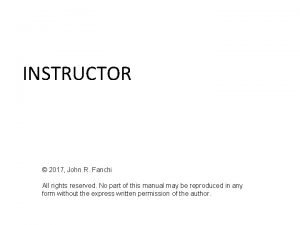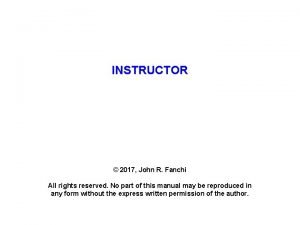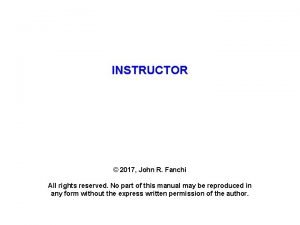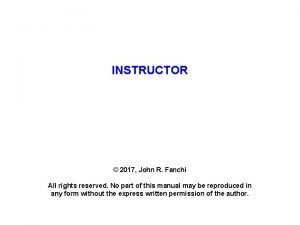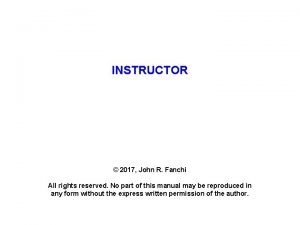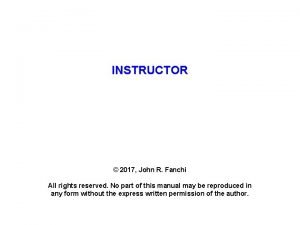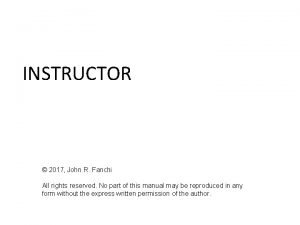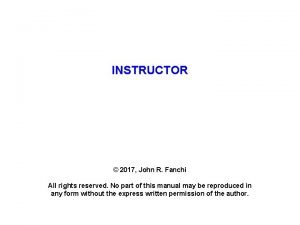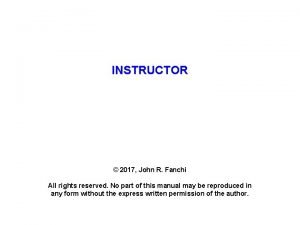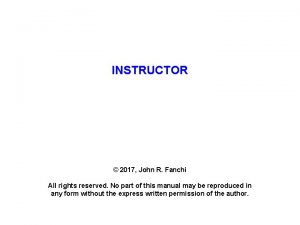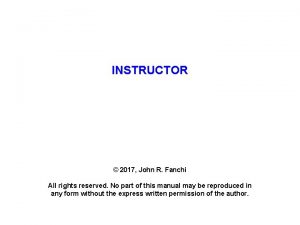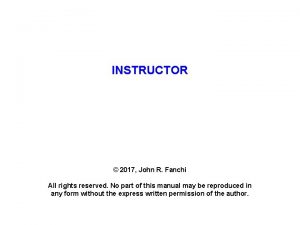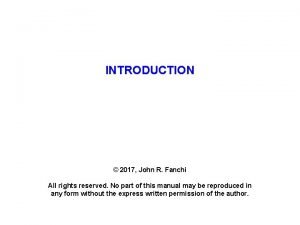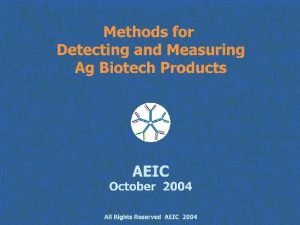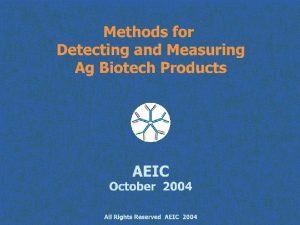INSTRUCTOR 2017 John R Fanchi All rights reserved





![Top 5 Oil Producing Nations as of 2014 [US EIA Petroleum, 2015; BP, 2015] Top 5 Oil Producing Nations as of 2014 [US EIA Petroleum, 2015; BP, 2015]](https://slidetodoc.com/presentation_image/3f6705c014c4497084c34d40fdad84e8/image-6.jpg)
![Top 5 Oil Consuming Nations as of 2014 [US EIA Petroleum, 2015; BP, 2015] Top 5 Oil Consuming Nations as of 2014 [US EIA Petroleum, 2015; BP, 2015]](https://slidetodoc.com/presentation_image/3f6705c014c4497084c34d40fdad84e8/image-7.jpg)















![World Proved Reserves from 2000 - 2014 [US EIA Petroleum, 2015] World Proved Reserves from 2000 - 2014 [US EIA Petroleum, 2015]](https://slidetodoc.com/presentation_image/3f6705c014c4497084c34d40fdad84e8/image-23.jpg)

![Nations with Largest Shale Oil Resources at the end of 2011 [WEC WER, 2013] Nations with Largest Shale Oil Resources at the end of 2011 [WEC WER, 2013]](https://slidetodoc.com/presentation_image/3f6705c014c4497084c34d40fdad84e8/image-25.jpg)
![Shale Plays in the contiguous United States [Source: US EIA, 2015] Shale Plays in the contiguous United States [Source: US EIA, 2015]](https://slidetodoc.com/presentation_image/3f6705c014c4497084c34d40fdad84e8/image-26.jpg)







- Slides: 33

INSTRUCTOR © 2017, John R. Fanchi All rights reserved. No part of this manual may be reproduced in any form without the express written permission of the author.

To the Instructor The set of files here are designed to help you prepare lectures for your own course using the text Introduction to Petroleum Engineering, J. R. Fanchi and R. L. Christiansen (Wiley, 2017) File format is kept simple so that you can customize the files with relative ease using your own style. You will need to supplement the files to complete the presentation topics.

THE FUTURE OF ENERGY © 2017, John R. Fanchi All rights reserved. No part of this manual may be reproduced in any form without the express written permission of the author.

Outline Ø Oil and Gas Production and Consumption Ø Resources and Reserves Ø Conventional Oil and Gas Ø Unconventional Oil and Gas Homework: IPE Ch. 2

OIL AND GAS PRODUCTION AND CONSUMPTION
![Top 5 Oil Producing Nations as of 2014 US EIA Petroleum 2015 BP 2015 Top 5 Oil Producing Nations as of 2014 [US EIA Petroleum, 2015; BP, 2015]](https://slidetodoc.com/presentation_image/3f6705c014c4497084c34d40fdad84e8/image-6.jpg)
Top 5 Oil Producing Nations as of 2014 [US EIA Petroleum, 2015; BP, 2015]
![Top 5 Oil Consuming Nations as of 2014 US EIA Petroleum 2015 BP 2015 Top 5 Oil Consuming Nations as of 2014 [US EIA Petroleum, 2015; BP, 2015]](https://slidetodoc.com/presentation_image/3f6705c014c4497084c34d40fdad84e8/image-7.jpg)
Top 5 Oil Consuming Nations as of 2014 [US EIA Petroleum, 2015; BP, 2015]

Top 5 Dry Natural Gas Producing Nations as of 2014 [US EIA Petroleum, 2015; BP 2015]

Top 5 Dry Natural GAs Consuming Nations as of 2014 [US EIA Petroleum, 2015; BP, 2015]

RESOURCES AND RESERVES

Resource Pyramid

Hydrocarbon Resource Triangle Conventional: High Quality Smaller volume Easy to develop Medium Quality Unconventional: Larger volume Difficult to develop Low-perm oil Gas shales Gas hydrates Tight gas sands Heavy oil Coal gas Oil shales After Fig. 1, SPE 143066 (2011)

Volumetric Reserves Ø Volume of oil = (V × × So × R) / Bo Ø Volume of gas = (V × × Sg × R) / Bg Ø where Ø Ø Ø Ø V = reservoir volume = porosity So = oil saturation Sg = gas saturation R = recovery factor Bo = oil FVF Bg = gas FVF

Ultimate Recovery = Past Production + Reserves Ultimate recovery Amount of Oil and/or Gas Produced over entire life Production Amount of Oil/Gas Produced to date Reserves Amount of Oil/Gas Forecast to be produced from date going forward

Deterministic and Probabilistic Reserves Ø Deterministic Ø “When a single best estimation of reserves is made based upon known geological, engineering, and economic data” Ø Probabilistic Ø “When the known geological, engineering, and economic data are used to generate a range of estimates and their associated probabilities”

SPE/WPC Reserves Proved Probable Possible ● Those quantities of petroleum, which by analysis of geoscience and engineering data, can be estimated with reasonable certainty to be commercially recoverable, from a given date forward, from known reservoirs and under defined economic conditions, operating methods, and government regulations. ● There should be at least a 90% probability (P 90) that the quantities actually recovered will equal or exceed the estimate. ● Those additional reserves which analysis of geoscience and engineering data indicate are less likely to be recovered than Proved Reserves but more certain to be recovered than Possible Reserves. ● There should be at least a 50% probability (P 50) that the quantities actually recovered will equal or exceed the estimate. ● Those additional reserves which analysis of geoscience and engineering data suggests are less likely to be recoverable than Probable Reserves. ● There should be at least a 10% probability (P 10) that the quantities actually recovered will equal or exceed the estimate.

Reserves and Probability for a Normal Distribution Proved Reserves = P 90 = mean – 1. 28×(std dev) Probable Reserves = P 50 = mean Possible Reserves = P 10 = mean + 1. 28×(std dev)

PRMS Petroleum Resources Management System Production Commercial Petroleum Initially-in. Place (PIP) Discovered PIP Reserves 1 P Sub. Commercial 2 P 3 P Contingent Resources 1 C 2 C 3 C Unrecoverable Undiscovered PIP Prospective Resources Unrecoverable Source: A. W. Stokes, paper SPE 170885, summarized in pp. 97 -99, JPT [Dec 2014]

Production Reserves Discovered PIP Contingent Resources Project Maturity Subclasses RC On production 1 Approved for Development 2 Justified for Development 3 Development Pending 4 Development Unclarified or on Hold 5 Development Not Viable 6 7 Unrecoverable Undiscovered PIP Prospective Resources Unrecoverable Prospect 8 Lead 9 Play 10 Increasing Chance to be Commercial PRMS Resource Class (RC) Source: A. W. Stokes, paper SPE 170885, summarized in pp. 97 -99, JPT [Dec 2014]

CONVENTIONAL OIL AND GAS

Nations with Largest Crude Oil and Natural Gas Proved Reserves in 2014 [US EIA Petroleum website, 2015] Crude Oil Reserves (billion barrels) World Venezuela Saudi Arabia Canada Iran Iraq Kuwait United Arab Emirates Russia Libya Nigeria United States Kazakhstan 1656 298 268 173 157 140 104 98 80 48 37 36 30 Natural Gas Reserves (trillion cubic feet) World Russia Iran Qatar United States Saudi Arabia Turkmenistan United Arab Emirates Venezuela Nigeria Algeria China Iraq 6972 1688 1193 885 338 291 265 215 196 181 159 155 112

Regional Distribution of Crude Oil and Natural Gas Proved Reserves in 2014 [US EIA Petroleum website, 2015] Crude Oil Reserves (billion barrels) World Middle East Central & South America North America Africa Eurasia 1656 804 328 220 127 119 Asia & Oceania 46 Europe 12 Natural Gas Reserves (trillion cubic feet) World 6972 Middle East 2813 Eurasia 2178 Africa 606 Asia & Oceania 540 North America 422 Central & South 277 America Europe 136
![World Proved Reserves from 2000 2014 US EIA Petroleum 2015 World Proved Reserves from 2000 - 2014 [US EIA Petroleum, 2015]](https://slidetodoc.com/presentation_image/3f6705c014c4497084c34d40fdad84e8/image-23.jpg)
World Proved Reserves from 2000 - 2014 [US EIA Petroleum, 2015]

UNCONVENTIONAL OIL AND GAS
![Nations with Largest Shale Oil Resources at the end of 2011 WEC WER 2013 Nations with Largest Shale Oil Resources at the end of 2011 [WEC WER, 2013]](https://slidetodoc.com/presentation_image/3f6705c014c4497084c34d40fdad84e8/image-25.jpg)
Nations with Largest Shale Oil Resources at the end of 2011 [WEC WER, 2013] Shale Oil Resource (billion barrels) 2011 United States 3706 China 354 Russia 248 Congo 100 Brazil 82
![Shale Plays in the contiguous United States Source US EIA 2015 Shale Plays in the contiguous United States [Source: US EIA, 2015]](https://slidetodoc.com/presentation_image/3f6705c014c4497084c34d40fdad84e8/image-26.jpg)
Shale Plays in the contiguous United States [Source: US EIA, 2015]

Nations with Largest Volumes of Natural Bitumen and Extra Heavy Oil at end 2008 [WEC, 2010, Tables 4 -1 and 4 -2] Natural Bitumen (Tar Sands) Total Original Oil in Place (billion barrels) Canada 2434 Kazakhstan 421 Russia 347 United States 53 Nigeria 38 Extra Heavy Oil Total Original Oil in Place (billion barrels) Venezuela 2446 United Kingdom 11. 8 Azerbaijan 8. 9 China 8. 8 Italy 2. 7

Size of Unconventional Gas Resources in the United States circa January 2009 [NGSA Unconventional Gas, 2009] Trillion Cubic Resource Source Feet Tight gas 309 US EIA Shale gas 742 US FERC Coal gas 163 US PGC Permeability microdarcy nanodarcy Cleats

Methane Hydrate Structure USGS Burning_hydrate_inlay_US_Office_Naval_Research. jpg Water Methane Burning ice From: http: //geology. usgs. gov/connections/mms/joint_projects/methane. htm; A burning methane hydrate chunk - inlay is a lattice of the clathrate

The Gas Hydrates Resource Pyramid Source: Roy Boswell and Timothy S. Collett, “The Gas Hydrate Resource Pyramid, ” Fire in the Ice, Methane Hydrate R&D Program Newsletter, Fall 2006.

Working with Communities Ø ANSI – API Bulletin 100 -3: Community Engagement Ø Consequence of unconventional resource development Ø Prepare communities for exploration activities Ø Minimize disruption to communities Ø Manage resources Source: J. Donnelly, “Community Engagement, ” JPT, Sep. 14, pg. 18

QUESTIONS?

SUPPLEMENT
 2017 all rights reserved
2017 all rights reserved All rights reserved example
All rights reserved example Copyright 2015 all rights reserved
Copyright 2015 all rights reserved All rights reserved sentence
All rights reserved sentence Creative commons vs all rights reserved
Creative commons vs all rights reserved Confidential all rights reserved
Confidential all rights reserved Sentinel-controlled repetition
Sentinel-controlled repetition Copyright 2015 all rights reserved
Copyright 2015 all rights reserved Pearson education inc all rights reserved
Pearson education inc all rights reserved Microsoft corporation. all rights reserved.
Microsoft corporation. all rights reserved. Microsoft corporation. all rights reserved.
Microsoft corporation. all rights reserved. Microsoft corporation. all rights reserved
Microsoft corporation. all rights reserved Pearson education inc. all rights reserved
Pearson education inc. all rights reserved Dell all rights reserved copyright 2009
Dell all rights reserved copyright 2009 Warning all rights reserved
Warning all rights reserved All rights reserved c
All rights reserved c All rights reserved formula
All rights reserved formula Warning all rights reserved
Warning all rights reserved Confidential all rights reserved
Confidential all rights reserved Microsoft corporation. all rights reserved
Microsoft corporation. all rights reserved 2010 pearson education inc
2010 pearson education inc Copyright © 2018 all rights reserved
Copyright © 2018 all rights reserved Copyright 2010 pearson education inc
Copyright 2010 pearson education inc Pearson education inc. all rights reserved
Pearson education inc. all rights reserved Confidential all rights reserved
Confidential all rights reserved Confidential all rights reserved
Confidential all rights reserved R rights reserved
R rights reserved Rights reserved
Rights reserved Positive rights vs negative rights
Positive rights vs negative rights Difference between riparian and littoral rights
Difference between riparian and littoral rights Legal rights and moral rights
Legal rights and moral rights Legal rights and moral rights
Legal rights and moral rights What are negative rights
What are negative rights Negative rights
Negative rights


























